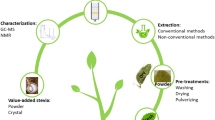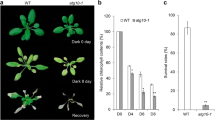Abstract
Plant-derived extracellular vesicles (EVs), containing a myriad of bioactive proteins, microRNAs, lipids, and secondary metabolites, have recently become the focus of rising interest due to their important roles in various applications. The widely accepted method for isolating plant EVs is differential ultracentrifugation plus density gradient centrifugation. However, the combination of differential ultracentrifugation and density gradient centrifugation for the isolation of plant EVs is time-consuming and labor-intensive. Hence, there is a need for more efficient methods to perform the separation of plant EVs. In this study, EVs were separated from Arabidopsis thaliana leaves by a cost-effective polyethylene glycol (PEG)-based precipitation approach. The mean size of purified Arabidopsis thaliana EVs determined by dynamic light scattering was 266 nm, which is consistent with nanoparticle tracking analysis. The size was also confirmed via transmission electron microscopy with morphology of a cup-shaped appearance which is the typical mammalian exosome’s morphology. Additionally, Western blotting of the purified Arabidopsis thaliana EVs, using commercially available mammalian exosomal kits, displayed surface marker tetraspanin proteins (CD9, CD63, and CD81), and endosomal sorting complexes required for transport (ESCRT)-associated proteins (TSG101 and ALIX). This demonstrates that the purified Arabidopsis thaliana EVs reveal the typical proteins reported in mammalian exosomes.




Similar content being viewed by others
Data availability
The data that support the findings of this study are available from the corresponding author upon reasonable request.
References
An Q, Ehlers K, Kogel K, van Bel A, Huckelhoven R (2006) Multivesicular compartments proliferate in susceptible and resistant MLA12-barley leaves in response to infection by the biotrophic powdery mildew fungus. New Phytol 172:563–576. https://doi.org/10.1111/j.1469-8137.2006.01844.x
Baker M (2015) Reproducibility crisis: blame it on the antibodies. Nature 521:274–276. https://doi.org/10.1038/521274a
Boavida L, Qin P, Broz M, Becker J, McCormick S (2013) Arabidopsis tetraspanins are confined to discrete expression domains and cell types in reproductive tissues and form homo- and heterodimers when expressed in yeast. Plant Physiol 163:696–712. https://doi.org/10.1104/pp.113.216598
Boing A, Pol E, Grootemaat A, Coumans F, Sturk A, Nieuwland R (2014) Single-step isolation of extracellular vesicles by size-exclusion chromatography. J Extracell Vesicles 3:23430. https://doi.org/10.3402/jev.v3.23430
Cai Q, Qiao L, Wang M, He B, Lin F, Palmquist J, Huang S, Jin H (2018) Plants send small RNAs in extracellular vesicles to fungal pathogen to silence virulence genes. Science 360:1126–1129. https://doi.org/10.1126/science.aar4142
Colombo M, Raposo G, Théry C (2014) Biogenesis, secretion, and intercellular interactions of exosomes. Annu Rev Cell Dev Biol 30:255–289. https://doi.org/10.1146/annurev-cellbio-101512-122326
Comfort N, Bloomquist T, Shephard A, Petty C, Cunningham A, Hauptman M, Phipatanakul W, Baccarelli A (2021) Isolation and characterization of extracellular vesicles in saliva of children with asthma. Extracell Vesicles Circ Nucl Acids 2:29–48. https://doi.org/10.20517/evcna.2020.09
Gardiner C, Vizio D, Sahoo S, Théry C, Witwer K, Wauben M, Hill A (2016) Techniques used for the isolation and characterization of extracellular vesicles: results of a worldwide survey. J Extracell Vesicles 5:32945. https://doi.org/10.3402/jev.v5.32945
Hebert T (1963) Precipitation of plant viruses by polyethylene glycol. Phytopathology 53:361–366
Huang Y, Wang S, Cai Q, Jin H (2021) Effective methods for isolation and purification of extracellular vesicles from plants. J Integr Plant Biol 63:2020–2030. https://doi.org/10.1111/jipb.13181
Jung M, Mun J (2018) Sample preparation and imaging of exosomes by transmission electron microscopy. J vis Exp 131:e56482. https://doi.org/10.3791/56482
Kalarikkal S, Prasad D, Kasiappan R, Chaudhari S, Sundaram G (2020) A cost-effective polyethylene glycol-based method for the isolation of functional edible nanoparticles from ginger rhizomes. Sci Rep 10:4456. https://doi.org/10.1038/s41598-020-61358-8
Kim M, Park J (2022) Isolation of Aloe saponaria-derived extracellular vesicles and investigation of their potential for chronic wound healing. Pharmaceutics 14:1905. https://doi.org/10.3390/pharmaceutics14091905
Konoshenko M, Lekchnov E, Vlassov A, Vlassov A, Laktionov P (2018) Isolation of extracellular vesicles: general methodologies and latest trends. BioMed Res Int 2018:8545347. https://doi.org/10.1155/2018/8545347
Lee H, He X, Ni K, Carnino J, Jin Y (2021) Low concentration of polyethylene glycol facilitates separation of extracellular vesicles from bronchoalveolar lavage fluid. Am J Physiol Lung Cell Mol Physiol 320:L522–L529. https://doi.org/10.1152/ajplung.00318.2020
Liangsupree T, Multia E, Riekkola M (2021) Modern isolation and separation techniques for extracellular vesicles. J Chromatogr 1636:461773. https://doi.org/10.1016/j.chroma.2020.461773
Liu Y, Wu S, Koo Y, Yang A, Dai Y, Khant H, Osman S, Chowdhury M, Wei H, Li Y, Court K, Hwang E, Wen Y, Dasari S, Nguyen M, Tang E, Chehab W, Val N, Braam J, Sood A (2020) Characterization of and isolation methods for plant leaf nanovesicles and small extracellular vesicles. Nanomedicine: NBM 29:102271. https://doi.org/10.1016/j.nano.2020.102271
Ludwig A, Miroschedji K, Doeppner T, Borger V, Ruesing J, Rebmann V, Durst S, Jansen S, Bremer M, Behrmann E, Singer B, Jastrow H, Kuhlmann J, Magraoui F, Meyer H, Hermann D, Opalka B, Raunser S, Epple M, Horn P, Giebel B (2018) Precipitation with polyethylene glycol followed by washing and pelleting by ultracentrifugation enriches extracellular vesicles from tissue culture supernatants in small and large scales. J Extracell Vesicles 7:1528109. https://doi.org/10.1080/20013078.2018.1528109
Mathieu M, Névo N, Jouve M, Valenzual J, Maurin M, Verweij F, Palmulli R, Lankar D, Dingli F, Loew D, Rubinstein E, Boncompain G, Perez F, Théry C (2021) Specificities of exosome versus small ectosome secretion revealed by live intracellular tracking of CD63 and CD9. Nat Commun 12:4389. https://doi.org/10.1038/s41467-021-24384-2
Midekessa G, Godakumara K, Ord J, Viil J, Lattekivi F, Dissanayake K, Kopanchuk S, Rinken A, Andronowska A, Bhattacharjee S, Rinken T, Fazeli A (2020) Zeta potential of extracellular vesicles: toward understanding the attributers that determine colloidal stability. ACS Omega 5:16701–16710. https://doi.org/10.1021/acsomega.0c01582
Potestà M, Roglia V, Fanelli M, Pietrobono E, Gismondi A, Vumbaca S, Tsangueu R, Canini A, Colizzi V, Grelli S, Minutolo A, Montesano C (2020) Effect of microvesicles from Moringa oleifera containing miRNA on proliferation and apoptosis in tumor cell lines. Cell Death Discov 6:43. https://doi.org/10.1038/s41420-020-0271-6
Raiborg C, Stenmark H (2009) The ESCRT machinery in endosomal sorting of ubiquitylated membrane proteins. Nature 458:445–452. https://doi.org/10.1038/nature07961
Rider M, Hurwitz S, Meckes D Jr (2016) ExtraPEG: a polyethylene glycol-based method for enrichment of extracellular vesicles. Sci Rep 6:23978. https://doi.org/10.1038/srep23978
Roth R, Hillmer S, Funaya C, Chiapello M, Schumacher K, Presti L, Kahmann R, Paszkowski U (2019) Arbuscular cell invasion coincides with extracellular vesicles and membrane tubules. Nat Plants 5:204–211. https://doi.org/10.1038/s41477-019-0365-4
Rutter B, Innes R (2017) Extracellular vesicles isolated from the leaf apoplast carry stress-response proteins. Plant Physiol 173:728–741. https://doi.org/10.1104/pp.16.01253
Rutter B, Innes R (2020) Growing pains: addressing the pitfalls of plant extracellular vesicle research. New Phytol 228:1505–1510. https://doi.org/10.1111/nph.16725
Rutter B, Rutter K, Innes R (2017) Isolation and quantification of plant extracellular vesicles. Bio Protoc 7:e2533. https://doi.org/10.21769/BioProtoc.2533
Tangwattanachuleeporn M, Muanwien P, Teethaisong Y, Somparn P (2022) Optimizing concentration of polyethelene glycol for exosome isolation from plasma for downstream application. Medicina 58:1600. https://doi.org/10.3390/medicina58111600
Vajda B (1978) Concentration and purification of viruses and bacteriophages with polyethylene glycol. Folia Microbiol 23:88–96. https://doi.org/10.1007/BF02876605
Van Deun J, Mestdagh P, Sormunen R, Cocquyt V, Vermaelen K, Vandesompele J, Bracke M, Wever O, Hendrix A (2014) The impact of disparate isolation methods for extracellular vesicles on downstream RNA profiling. J Extracell Vesicles 3:24858. https://doi.org/10.3402/jev.v3.24858
van Niel G, D’Angelo G, Raposo G (2018) Shedding light on the cell biology of extracellular vesicles. Nat Rev Mol Cell Biol 19:213–228. https://doi.org/10.1038/nrm.2017.125
Wang J, Ding Y, Wang J, Hillmer S, Miao Y, Lo S, Wang X, Robinson D, Jiang L (2010) EXPO, an exocyst-positive organelle distinct from multivesicular endosomes and autophagosomes, mediates cytosol to cell wall exocytosis in Arabidopsis and tobacco cells. Plant Cell 22:4009–4030. https://doi.org/10.1105/tpc.110.080697
Wang X, Huang J, Chen W, Li G, Li Z, Lei J (2022) The updated role of exosomal proteins in the diagnosis, prognosis, and treatment of cancer. Exp Mol Med 54:1390–1400. https://doi.org/10.1038/s12276-022-00855-4
Wu M, Ouyang Y, Wang Z, Zhang R, Huang P, Chen C, Li H, Li P, Quinn D, Dao M, Suresh S, Sadovsky Y, Huang T (2017) Isolation of exosomes from whole blood by integrating acoustics and microfluidics. Proc Natl Acad Sci USA 114:10584–10589. https://doi.org/10.1073/pnas.1709210114
Xiao J, Feng S, Wang X, Long K, Luo Y, Wang Y, Ma J, Tang Q, Jin L, Li X, Li M (2018) Identification of exosome-like nanoparticle-derived microRNAs from 11 edible fruits and vegetables. PeerJ 6:e5186. https://doi.org/10.7717/peerj.5186
Yamamoto K, Alberts B, Benzinger R, Lawhorne L, Treiber G (1970) Rapid bacteriophage sedimentation in the presence of polyethylene glycol and its application to large-scale virus purification. Virology 40:734–744. https://doi.org/10.1016/0042-6822(70)90218-7
Yang D, Zhang W, Zhang H, Zhang F, Chen L, Ma L, Larcher L, Chen S, Liu N, Zhao Q, Tran P, Chen C, Veedu R, Wang T (2020) Progress, opportunity, and perspective on exosome isolation - efforts for efficient exosome-based theranostics. Theranostics 10:3684–3707. https://doi.org/10.7150/thno.41580
Yoo C, Kim G, Kim M, Park D, Kang H, Lee M, Huh N (2012) A direct extraction method for microRNAs from exosomes captured by immunoaffinity beads. Anal Biochem 431:96–98. https://doi.org/10.1016/j.ab.2012.09.008
Funding
This research is supported by the National Institute of Food and Agriculture – AFRI Project 1028230 and Hatch Project 7007183.
Author information
Authors and Affiliations
Contributions
Sharjeel Jokhio: methodology, investigation, formal analysis, validation, and writing—original draft. Ian Peng: methodology, investigation, formal analysis, validation, and writing—original draft. Ching-An Peng: conceptualization, methodology, investigation, formal analysis, validation, supervision, funding acquisition, project administration, resources, and writing—review and editing.
Corresponding author
Ethics declarations
Conflict of interest
The authors declare no competing interests.
Additional information
Communicated by Handling Editor: Liwen Jiang.
Publisher's Note
Springer Nature remains neutral with regard to jurisdictional claims in published maps and institutional affiliations.
Rights and permissions
Springer Nature or its licensor (e.g. a society or other partner) holds exclusive rights to this article under a publishing agreement with the author(s) or other rightsholder(s); author self-archiving of the accepted manuscript version of this article is solely governed by the terms of such publishing agreement and applicable law.
About this article
Cite this article
Jokhio, S., Peng, I. & Peng, CA. Extracellular vesicles isolated from Arabidopsis thaliana leaves reveal characteristics of mammalian exosomes. Protoplasma (2024). https://doi.org/10.1007/s00709-024-01954-x
Received:
Accepted:
Published:
DOI: https://doi.org/10.1007/s00709-024-01954-x




